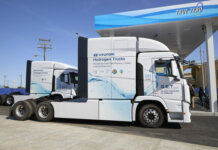Pacific Gas and Electric Co. (PG&E) has rolled out its new EV Fleet Savings Calculator, which allows business customers and public agencies with medium- to heavy-duty fleet vehicles to explore EV investment estimates based on their own fleet sizes, infrastructure, budget and other factors.
The EV Fleet Savings Calculator uses calculations based on PG&E’s new Business EV Rate to enable fleets to evaluate their plans by analyzing how much they can save by switching to EVs. The tool helps customers better understand key total-cost-of-ownership factors, including incentives, energy costs, infrastructure considerations and participation in California’s statewide Low Carbon Fuel Standard (LCFS).
After customers input information on vehicles and usage, the tool offers recommendations for charging infrastructure, charging schedule based on fleet needs, how much they can save on fuel costs, revenue they could generate from LCFS, and estimated reductions in greenhouse-gas emissions.
PG&E notes that its new Business EV Rate enables customers on the new rate to save up to 40% on charging costs, on average, compared to previous rate options. These customers also achieve cost savings through a new feature called a subscription charge, which allows customers to choose the amount of kilowatt power they need for their charging stations, similar to choosing a data plan for a phone bill. This subscription charge can be much lower than current rate options, and allows customers to have simpler, more consistent monthly costs.
On the Business EV Rate, customers pay for the electricity used by the EV chargers and the monthly subscription charge. Customers can adjust their subscription levels up or down to meet their changing needs for EV charging.
PG&E’s EV Fleet program is another mechanism through which the utility helps customers with medium-duty, heavy-duty and off-road fleets begin to transition their fleet vehicles to electricity. Through the program, PG&E builds the electrical infrastructure for customers’ EVs from the utility pole to the customer meter or to the charger, depending on which ownership option the customer chooses.





